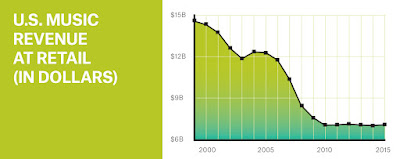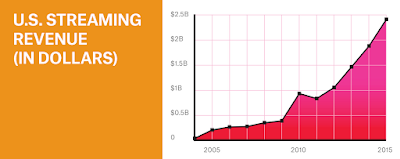The death of the CD and the ressurection of Radio
It's no mystery that the music or record business has been on the steady decline since the year 2000 hit the scene. From the Napster days, to Shoutcast, to burning CDs, to Limewire, to illegal Blogs/Forums, to iTunes, and now to Spotify, the listeners have been running rampant like it was the music apocalypse. However, now that the technology dust has settled so have the majority of the listener base. The sales for CDs or physical media are almost non-existent, and they continued to plunge through out the first half of 2016. In contrast, the RIAA announced that recorded music generated 8.1 percent more revenue in the first six months of 2016 than it did during the first half of 2015. So now that the we're finished going downhill, hopefully we can start climbing back up again.
 |
| The Music Biz Camel Hump; Now your's Chance to do the Hump |
According to the RIAA, the increase in digital sales came from a massive growth spurt of service subscribers. While 2015 peaked with 10.8 million subscribers, the amount of subscribers reached 18.3+ million by the first half of 2016. In addition, the European market went up as well, with an increase in France by 6 percent, and the U.K by 10.9 percent. However, keep in mind this is only for digital subscribers, with most of them coming from a small handful of sources. Major labels have played a significant role in Spotify's success, with an 18% ownership through equity, and other undisclosed ad campaign amounts. This has firmly placed them in first place with over 40 million paid subscribers. Apple Music is now second with 17 million, but that could all change by early 2017 with over 60 million Amazon Prime members being spammed daily. Furthermore, iHeart Radio and YouTube Red are serious competitors as well.
 |
| 2010... R.I.P CDs |
 |
| Metal rules...on Spotify |
Independent Artists will need to focus more on driving plays and subscribers to their member pages, rather than online downloadable purchases. Instead of funneling your social media followers to your music download store(s), you will need to direct them to your streaming network member pages.
The good news? In the past, new music used to generate more revenue than shelved music, but due to the new system that's been reversed. The earning span of most music has continually risen over the years, and is expected to continue rising. Old "New" music is being re-discovered everyday, and listeners are jumping onto alternate choices of the mainstream norm. Online radio stations have become very popular, from TuneIn, to Shoutcast, to other popular online directories there's something for everyone.
Shoutcast was the first form of streaming music created back in 1998. I still remember making my own themes for Winamp back in the early 2000s, while browsing the directory of online stations. In 2009 they announced that they had over 900 thousand listeners, with that amount being well over 1 million by now. In addition, there are hundreds of undocumented private streams which could contain thousands of listeners in total. They are now, in 2016, syndicated through many mobile, Android, and iPhone apps making it even easier for new listeners to find new stations. Furthermore, they are even being syndicated through Apple Radio reaching all Apple Music subscribers.
 |
| Shoutcast back in December 2000 |
So then should I invest everything into Spotify or a smaller market such as Shoutcast? You should really invest into all, as many avenues as possible. However, it's all in vain if you don't secure your royalties. There are three main types in addition to the standard shares the providers offer.
- Mechanical
- Performance
- Usage
On average, Spotify will pay you about half a cent ($0.005) per stream. Their contract states 70%, but keep in mind that is only for shared revenue (not gross). In addition to that, they also state it only includes revenue which they receive back to the rights holders. So for example, let's say you obtain your licensing and publishing through CD Baby, then you can guess who ends up keeping a large chunk of your money. But that is the cost of doing business, so in 2017 invest wisely in your ad campaigns. At less than half a cent per stream, you will have to carefuly watch your advertising budget, and probably re-adjust more periodically than normal. Putting all your chips into one table is probably not a good idea. Instead build houses and stack up points when your turn is up like bones, Domino!
www.76radio.com - Home of Independent Artists
